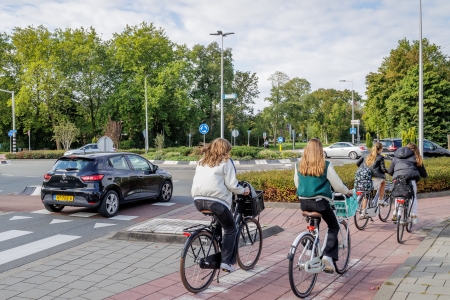
Mode of transport
Transport mode is one of the main factors in crashes with young road users. Young road users cycle a lot and cycling involves a higher crash risk than driving for instance (see SWOV fact sheet Road deaths in the Netherlands). When cycling, young road users are vulnerable ; unlike cars, bicycles do not offer physical protection against crashes [11]. When teenagers reach secondary school age, the number of annual cycling kilometres quadruples, compared to when they were at primary school. They travel almost as many kilometres by bicycle as they do by car: an average of 2000 km of their total mobility. Adolescents are not allowed to drive independently until they are 18, which means bicycle use – and (light) moped use from the age of 16 – increases. Unlike cars, these vehicles offer no physical protection, which increases injury risk by a factor of 6 (cyclists), 25 ((light) mopeds) or 9 (pedestrians) [6].
Risk behaviour
It is during adolescence that youngsters take more risks. This is due to the way the brain develops in this period. The influence of peers also increases at this time (See the question What changes does puberty bring?). By taking more risks in traffic, their crash risk also increases. In children aged 11-13, Twisk & Vlakveld [12] found an association between risk behaviour and crashes. A literature review of mostly American literature by Ouimet et al. [13] shows that, compared to older men, young male drivers run a higher crash risk when they are joined by peers than when they are not (in America driving is permitted at the age of 16).
Cycling skills
A study of teenage cycling skills in the last year of primary school (year 8), at age 11-13, shows that teenagers are poor at recognising danger, and have a limited risk awareness [14]. Youngsters with more cycling experience do not score any better. And, the skills of youngsters that often cycle the same route are worse than the skills of youngsters that cycle more diverse routes. Zeuwts et al. [15] show that, as they grow older and gain more cycling experience, youngsters do develop more cycling skills (balancing, stopping safely, steering, etc.).
Social environment
Peers play a role in unsafe road user behaviour, and it is hard for youngsters to withstand peer pressure [6]. Youngsters are easily challenged, they want to show off, or follow suggestions without thinking. Moreover, when cycling together with others, they have to divide their attention between traffic and each other; this increases their cognitive work load [16]. Cycling together also seems to affect the number of crashes. Research by VeiligheidNL [17] shows that youngsters aged 13-17 most often end up in an emergency room after cycling together with three or more others. Since youngsters often cycle in groups, they may be overrepresented.
Hazard recognition and risk assessment
Young road users are not too good at hazard recognition; the more complex the situation, the poorer they perform [14] [18] [19]. Research shows that even if they do recognise the hazard, they underestimate the danger of a situation more often than adults do, and they need more time to decide whether a situation is hazardous [20] [21]. When youngsters have time to reflect, for example when completing a questionnaire, they do not show less awareness of hazards than adults do and are sometimes even more aware of possible risks. When youngsters are asked about their risky road user behaviour, they overestimate the fatality risk to an unrealistic degree [18].
Gender
Boys are more prone to take risks than girls. Self-reporting shows girls to attach more importance to safe cycling than boys [22]. In addition, boys appear to be more sensation seeking, showing a later peak (at age 19) in sensation seeking behaviour than girls (peak at age 16) [9]. Boys aged 12 to 17 are more often killed in traffic than girls of that same age (Figure 7). However, it is unknown whether they participate in traffic more often than girls, which would imply a higher exposure to risk. Therefore, traffic risk for boys versus girls is also unknown.
Figure 7. Number of registered road deaths among boys and girls aged 12 to 17 between 2009 and 2018. Source: Statistics Netherlands (Road Death Statistics).
